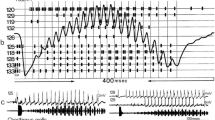Abstract
THE classical work of Regen1 on the effect of artificially produced sounds on the stridulation behaviour of Pholidoptera (= Thamnotrizon) aptera (Fab.) has prompted similar work on the related British species Ph. griseoaptera (De Geer), with the view of clarifying our understanding of the factors involved in the alternation ‘singing’ of males and the response to sound by females. There appears to be some confusion in the literature about the conditions under which Regen induced his insects to ‘sing’ in alternation with artificial signals. The widely accepted view2,3 is that he was able to obtain this response only from newly moulted adults which had not already learnt to sing in concert with other males. In fact, Regen points out that young males do not alternate at all until they have ‘sung’ together for some time and his experiments did not begin until they had started to alternate for long periods. There seems to be little evidence that his earlier failures, with older males, were due to learning by the insect, and other work in this field4,5 supports the view that any recognition of the specific ‘song’ is due to inborn mechanisms.
Similar content being viewed by others
References
Regen, J., S.B. Akad. Wiss. Wien, 135, 329 (1926).
Pumphrey, R. J., Biol. Rev., 15, 107 (1940).
Haskell, P. T., Insect Sounds (Witherby, London, 1961).
Weih, A. S., Z. Tierpsychol., 8, 1 (1951).
Busnel, R. G., and Loher, W., Colloque sur l'Acoustique des Orthopteres. Ann. Épiphyt. (tome hors serie), 365 (1955).
Busnel, R. G., Dumortier, B., and Busnel, M. C., Bull. Biol., 90, 219 (1956).
Author information
Authors and Affiliations
Rights and permissions
About this article
Cite this article
JONES, M. Sound Signals and Alternation Behaviour in Pholidoptera. Nature 199, 928–929 (1963). https://doi.org/10.1038/199928a0
Issue Date:
DOI: https://doi.org/10.1038/199928a0
- Springer Nature Limited





